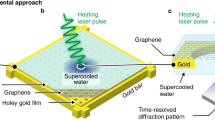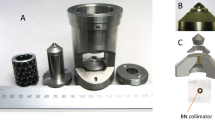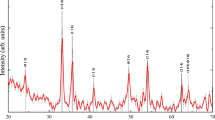Abstract
One of the most fundamental limitations to resolution in the electron microscopy of organic materials is the structural damage caused by the incident radiation. While the primary inelastic interactions between the electrons and the specimen molecules cannot be stopped, it has been hoped that the use of very low temperatures would ‘freeze’ molecular fragments in place to allow extended microscopy of minimally damaged structures. Knapek and Dubochet1 have reported that the rate of damage is much less (30–300 times) when diffraction patterns of organic materials are observed in an electron microscope with a superconducting objective lens, in which the specimen is held at 4.2 K. Previous workers had not seen such an effect when using liquid helium cooled stages, and it was suggested1 that this was mostly due to insufficiently low temperature. A microscope with a superconducting objective lens, which was constructed at Oak Ridge National Laboratory2, has been installed recently at Duke University. We selected l-valine as a test material because it has been so extensively examined in the past. Knapek and Dubochet1 reported that l-valine crystals at 4.2 K could tolerate an electron dose 67 times greater than at room temperature and Dietrich et al.3, using the same microscope, reported a tolerance 87 times greater; we report here that it is only 4 to 6 times greater. We have tested effects of temperature and of the specimen substrate, both suggested as important components in the limitation of radiation damage, and we find no further improvement. The results of Knapek and Dubochet and Dietrich et al. therefore remain unconfirmed, and the mechanism and extent of protection from radiation-induced damage at low temperatures must remain under study.
This is a preview of subscription content, access via your institution
Access options
Subscribe to this journal
Receive 51 print issues and online access
$199.00 per year
only $3.90 per issue
Buy this article
- Purchase on Springer Link
- Instant access to full article PDF
Prices may be subject to local taxes which are calculated during checkout
Similar content being viewed by others
References
Knapek, E. & Dubochet, J. J. molec. Biol. 141, 147–161 (1980).
Worsham, R. E., Harris, W. W., Mann, J. E., Richardson, E. G. & Ziegler, N. F. Proc. 32nd a. Meet. EMSA, 412–413 (Claitor's, Baton Rouge, 1974).
Dietrich, I., Dubochet, J., Fox, K., Knapek, E. & Weyl, R. in Electron Microscopy at Molecular Dimensions (eds Baumeister, W. & Vogell, W.) 234–244 (Springer, Berlin, 1980).
Parkinson, G. M., Jones, W. & Thomas, J. M. in Electron Microscopy at Molecular Dimensions (eds Baumeister, W. & Vogell, W.) 208–225 (Springer, Berlin, 1980).
Box, H. in Physical Aspects of Electron Microscopy and Microbeam Analysis (eds Siegel, B. M. & Beaman, D. R.) 279–533 (Wiley, New York, 1975).
Worsham, R. E. & Mann, J. E. Proc. 34th a. Meet. EMSA, 532–533 (Claitor's, Baton Rouge, 1976).
Talmon, Y. J. Microsc. 125, 227–237 (1982).
Torii, K. & Iitaka, Y. Acta crystallogr. B26, 1317–1326 (1970).
Glaeser, R. M. & Taylor, K. A. J. Microsc. 112, 127–138 (1978).
Lefranc, G. & Müller, K.-H. in Electron Microscopy and Analysis 1981 (ed. Goringe, M. J.) 91–94 (Institute of Physics, Bristol, 1982).
Heide, H. G., Herrmann, K.-H. & Jäger, J. Proc. 10th int. Congr. Electr. Microsc., Hamburg, Vol. 2, 457–458 (Deutsche Gesellschaft für Elektronenmikroskopie, e.V., Frank-furt/Main, 1982).
Grubb, D. T. & Groves, G. W. Phil. Mag. 24, 815–828 (1971).
Lamvik, M. K., Müller, K.-H. & Weiss, K. Proc. 40th a. Meet. EMSA, 376–377 (Claitor's, Baton Rouge, 1982).
Dietrich, I., Formanek, H., Fox, F., Knapek, E. & Weyl, R. Nature 277, 380–381 (1979).
Reimer, L. in Physical Aspects of Electron Microscopy and Microbeam Analysis (eds Siegel, B. M. & Beaman, D. R.) 231–245 (Wiley, New York, 1975).
Author information
Authors and Affiliations
Rights and permissions
About this article
Cite this article
Lamvik, M., Kopf, D. & Robertson, J. Radiation damage in l-valine at liquid helium temperature. Nature 301, 332–334 (1983). https://doi.org/10.1038/301332a0
Received:
Accepted:
Issue Date:
DOI: https://doi.org/10.1038/301332a0
This article is cited by
Comments
By submitting a comment you agree to abide by our Terms and Community Guidelines. If you find something abusive or that does not comply with our terms or guidelines please flag it as inappropriate.



